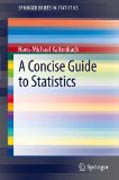
The text gives a concise introduction into fundamental concepts in statistics. Chapter 1: Short exposition of probability theory, using generic examples. Chapter 2: Estimation in theory and practice, using biologically motivated examples. Maximum-likelihood estimation in covered, including Fisher information and power computations. Methods for calculating confidence intervals and robustalternatives to standard estimators are given. Chapter 3: Hypothesis testing with emphasis on concepts, particularly type-I , type-II errors, and interpreting test results. Several examples are provided. T-tests are used throughout, followed important other tests and robust/nonparametric alternatives. Multipletesting is discussed in more depth, and combination of independent tests is explained. Chapter 4: Linear regression, with computations solely based on R. Multiple group comparisons with ANOVA are covered together with linear contrasts, again using R for computations. Focus on concepts rather than long calculations . Several topics relevant to modern biology (multiple testing, minimax estimation) usually not found in similar texts . Concise first introduction or repetition of fundamental concepts in statistics - Pointers to relevant R functions and datatypes . Robust andnonparametric counterparts of classical estimators and tests given throughoutthe text. INDICE: Basics of Probability Theory. Estimation. Hypothesis Testing. Regression. References. Index.
- ISBN: 978-3-642-23501-6
- Editorial: Springer Berlin Heidelberg
- Encuadernacion: Rústica
- Páginas: 111
- Fecha Publicación: 18/09/2011
- Nº Volúmenes: 1
- Idioma: Inglés
